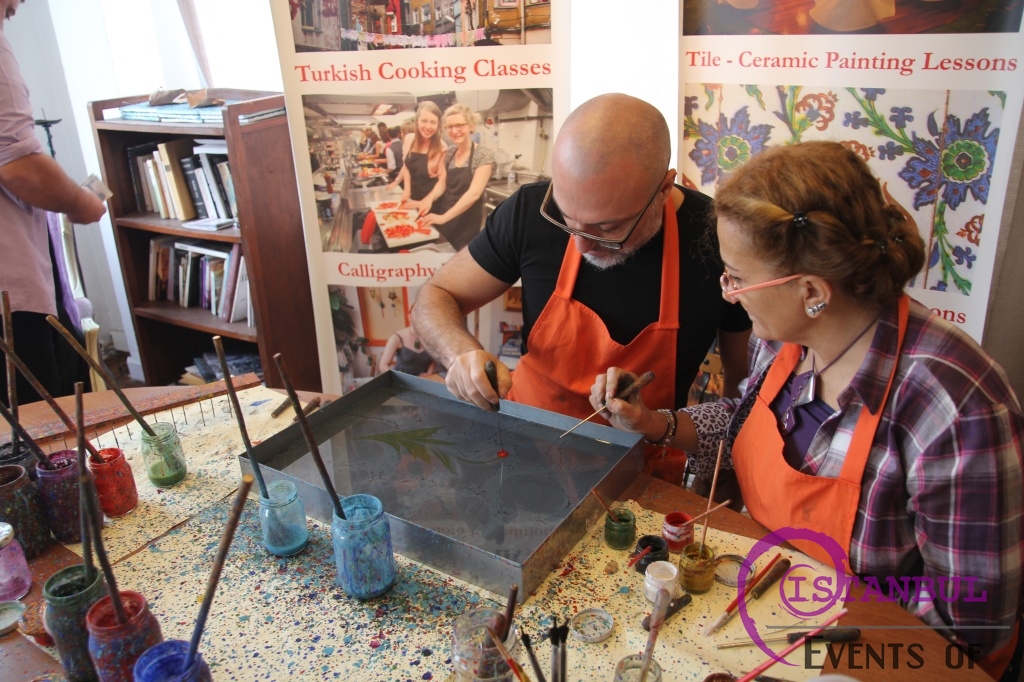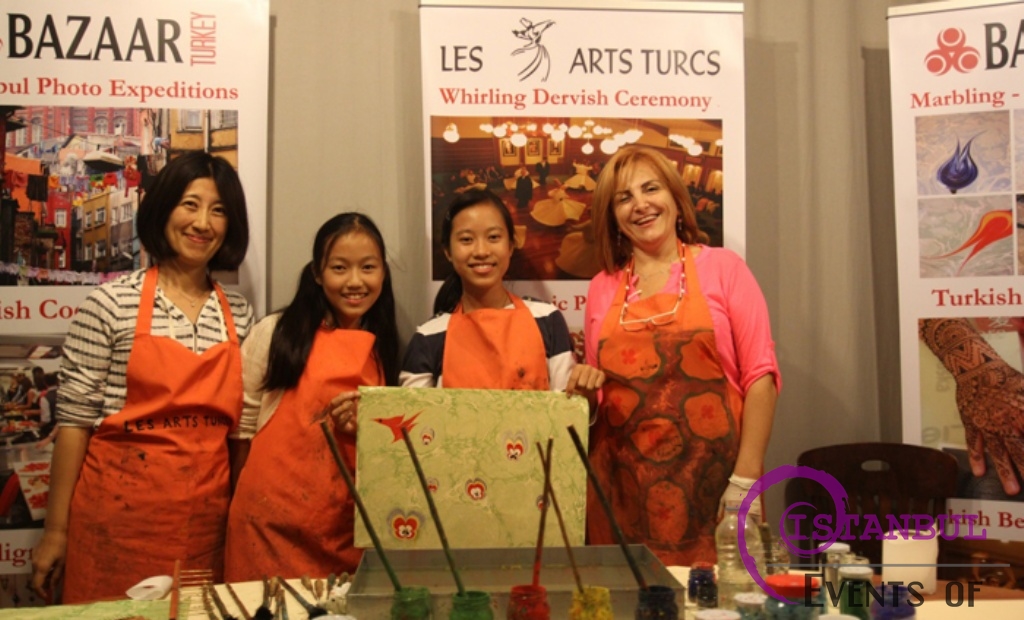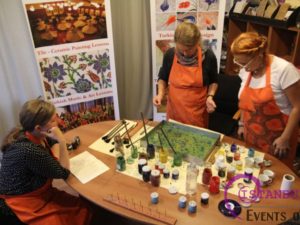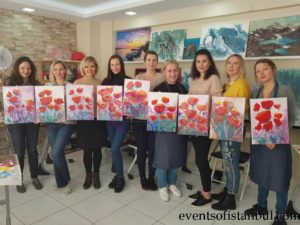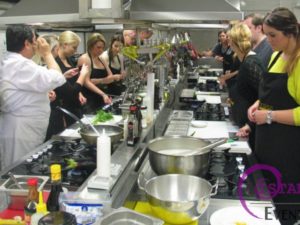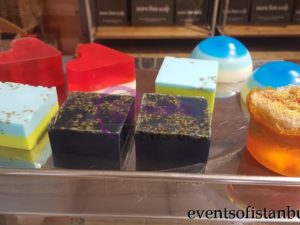Turkish Marbling Ebru Course Certificate Programme
550,00 EUR
Private Ebru Course Masterclass for all Levels in Istanbul.
Please ask for price. E-mail or +905442201022
Description
Turkish Marbling Ebru Course Certificate Programme
- Duration: 6 Days – 12 Hours workshop course / Masterclass
- Location: Sultanahmet / ISTANBUL
- Lesson Teachings: available in English, Turkish
Overview ;
6 Days Marbling – Ebru Class – Sultanahmet / English Tutoring.
Learn about the techniques of the traditional Ebru Art from out teachers in the center of istanbul – Sultanahmet. Spend a week in istanbul learning the art of Marbling.
Course Objective ;
The aim of this course is to teach the history and the application techniques of Turkish Ebru Art; the paints, equipment used in Turkish Ebru Art and the kinds of ebru.
Course Programme ;
Day 1
Meeting in our Art studio with our Teacher.
11:00 – 13:00 – Introduction to Ebru Art.
Day 2
11:00 – 13:00 – Ebru Art Class – Preparation of the Materials.
Day 3
11:00 – 13:00 – Ebru Art Class – Traditional techniques and transfering on paper.
Day 4
11:00 – 13:00 – Ebru Art Class – Traditional techniques and transfering on paper.
Day 5
11:00 – 13:00 – Visiting workshops, exhibitions and art material suppliers.
Day 6
11:00 – 13:00 -Ebru Art Class – Advanced techiques and experimental works.
What is Included ;
- In our lessons; we can teach beginner & advanced level Professional Artists
- 6 Days of Traditional Ottoman style paper marbling masterclass
- All equipment for Turkish Marbling – Ebru Workshop
- Workshop Area, Teaching.
- Turkish Tea & Water
Meeting Point ;
Here is our Art Studio Address ;
Google Maps : https://goo.gl/maps/uXuyRmELZsx
Events of Istanbul – Les Arts Turcs Art Studio
Alemdar Mh. Incili Cavus St.
No: 19 Floor : 3 (Behind The Underground Cistern)
Sultanahmet 34110
Istanbul, Turkey
Contact : Mr. Alp or Mr. Nurdogan ( Phone : +90 544 220 10 22 )
E-mail : info@eventsofistanbul.com
Cancellation Policy ;
Here in this link you can find the details about our cancellation policy.
Additional Information ;
LEARN the secrets of creating the rich patterns of handmade marble paper .
EXPERIENCE the sensuous flow of Ottoman Marble ( Ebru ).
CONTEMPORARY create design fabric marbling paper technique designs on paper, glass or on silk fabrics .
Our teachers are local Turkish Artisans and have experience in teaching.
Our Artists are Professional in Marbling – Ebru Art & Local Artisans.
TURKISH MARBLING, EBRU
Marbled paper, called ebru in Turkish, was used extensively in the binding of books and within the calligraphic panels in Turkey. The existing word ebre in Eastern Turkish, meaning variegated, points to the fact that marbling might have been known the populations of Central Asia. Its origin might ultimately hark back to China, where a document from the T’ang dynasty (618-907) mentions a process of coloring paper on water with five hues. In the early examples from the 16th c. in the Ottoman-Turkish era, ebru appears in the battal (stone) form, namely without any manipulation. Interestingly, several variations developed in time, giving us types such as gelgit, tarakli, hatip, bülbül yuvasi, çiçekli (respectively come-and-go, combed, preacher, nightingale’s nest, flowered, etc.) An attempt has been made here to show some of its principal patterns, with samples the master marblers of this century chosen from our collection.
Ebru technique consists of sprinkling colours containing a few drops of ox-gall on to the surface of the bath sized with kitre (gum tragacanth) in a trough. By carefully laying the paper over the bath, the floating picture on top of it is readily transferred to the paper; thus, each ebru is a one of a kind print. To obtain beautiful ebru results, one needs to have a light hand, refined taste, and an open mind to the unexpected patterns forming on the water. Patience and a good knowledge of traditional culture are characteristic of ebru masters.
After the 1550’s, booklovers in Europe prized ebru, which came to be known as ‘Turkish papers’. Many specimens in their collections and in the several album amicorum books are visible today in various museums. Also, early texts dealing with ebru, such as “Discourse on decorating paper in the Turkish manner”, published in 1664 Athanasius Kircher in Rome, helped to disseminate the knowledge of this kind of marbling art. There is agreement amongst scholars that the so-called Turkish Papers played a colourful influence on the book arts in Europe.
Ebru Marbling is a unique art which many painting and design lovers like to do in their spare time and especially demonstrate to their friends on different occasions. Nevertheless, this spectacular piece of art does have many applications in daily life where it is used to enhance the decor and look of the goods. This patterned paper is extensively used in the binding of books and within the calligraphic panels in Turkey. In addition to this, “ebru” works are often framed as pictures and used all over the world as a piece of decoration. Other than paper work, the pattern is often designed on leather, glass, cloth, furniture, book covers, notebooks, invitations, and many other areas to reflect the unique glamour of this art.
Materials used in Ebru Marbling Art
Gum tragacath – Dye – Paintbrush – Basin – Water – Paper – Gall
Gum Tragacant is obtained from trunk of a thorny plant growing naturally in Anatolian, Persian and Turkestan mountians and called “gaven”. The sap coming out of scratches made on the branches dries up later and solidifies in bone white colored pieces. It is dropped in water with very low hardness at the rate of 20-40 grams/3 litres and kept for two days.The gum having dissolved completely is filtered through a cloth bag and poured into the basin. It should have a dentisty of buttermilk.Gum tragacanth is widely used as herbal medicene(in throat and stomach diseases) in cosmetic and textile industry.
Dye are “mineral dyes” as it is called in clasiccal method obtained from natural metal oxides. Turkish is a very rich country in respect of such natural dyes.Any kind of earth may be first translated into mud then filtered and crushed to from a dye.
Painthbrushes; are made of horsehair bound around a rosetree stick, in a manner to from a circumference with hollow centre.Rosetree is preferred because it prevents mould. Brushes of different thickness and length enable dye application and dye control.
Basin is made of wood or metal of 4-6 cm. depth an about some milimeter larger than the paper size (to offset the dilatation of paper when wet). Usual paper zizes are 35X50 cm. or 25X35 cm.
Water; preferably withouth hardness.The ideal is distilled water. In older times rainwater was favorite but because of acide rain in our times it is no longer advisable.
Paper: The ideal paper is the one handmade and having a high absorbtion capacity and acid-free. On account of its rarity and high cost we don’t advise it to begginers. Instead, any kind of non glossy paper may be used. In order to increasethe absorbtion capaticy and to fix the dye on it(more durable) and alumina solution may be applied on the paper surface. Thus dyes are made more easy to fix.
Gall: The most importent metarial to make marbling. A marbler must well understand what gall is and its functions. To my openion the secret of the marbling lies in the gall. Its main functions are :
1. to ensure surface tension, dye spreading over the water surface otherwice dyes sink.
2. to prevent mixture of dyes. For instance when blue yellow are simultaneously applied and mixed up as much as possible never green comes out.
3. to assist dye fixation on the paper.
4. to give different shades of the same color and different size of patterns.
MARBLING APPLIED TO PAPER PATTERNS
Classical Types of Ebru;
1- Battal – Stone: The oldest recorded style in Ebru. It is the base of all forms in paper marbling art. The paints stay as they drop off the brush no other effect is given.
2- Gel Git – Tidal : After having a battal base, it is formed zigzag movements parallel to the sides of the basin. This tidal movement is sometimes applied diagonally as well.
3- Şal – Shawl : Formed an evenly spreading of two or three ‘S’ shapes on a tidal ebru in the opposite direction of the last tidal move.
4- Bülbül Yuvası – Nightingale Nest : Formed inside to outside spiral movements next to each other on a battal ebru.
5- Taraklı – Combed : A vertically made tidal ebru is combed in the opposite direction of the last tidal movement.
6- Kumlu – Sandy : Formed continuously dropping of low density paint on an extremely thickened basin and letting the work sit for a long time. The surface tension is high in an extremely thickened basin. The low-density paint is going to be pressured under the high tension of the surface and after a while crack and form the sandy or bony ebru.
7- Hafif – Light : Paints are diluted more than in other ebru types. Light ebru is usually used as a base to perform calligraphy.
8- Hatip – Orator : Motifs are formed giving movement effects to the paints that are distributed evenly within each other on the surface. Colors at the background are light, motif colors are intense.
9- Dalgalı – Wavy : When the paper is moved back and forth during the marbling, the result will appear as waves on the paper. The paper can be folded, (creases point the surface) when each move contacts with a crease it will change direction and will form the waves on the paper. Waves can be formed only if the movement has a regular rhythm.
10- Neftli Battal –Turpentine: This is obtained sprinkling paints with some added drops of Turpentine (preferably pine turpentine) onto a ‘Battal’ background. It gives a wavy appearance.
11- Somaki Battal – Porphyry: Generally made with two color. More gall is added to the second color, which squeezes the first color and creates thin veins, like marble.
12 – Serpmeli Battal – Sprayed: After any well known “Battal marbling” is made, a second color, in contrast to the background, is sprinkled is small droplets. The paint in the brush is squeezes out carefully, and some people use a special brush for sprinkling. This sprinkling may be formed in ‘Gel-Git’ – ‘ Bülbül Yuvası’ or other patterns.
13- Ak Kase – Stenciled Marbling: This is a pattern obtained making several imprints on the same background, and popular with calligraphers. The base consist of a ‘light marbling upon which the script is written using a special fluid prepared with gum Arabic applied with a red pen or brush. Thus the surface of the light marbling is covered (insulated) the gum Arabic. After drying, another design using darker colors is applied on the same paper: the parts covered with gum Arabic will resist the second coat and will therefore display the script. The same technique may be applied using a stencil, and other substances can be used instead of gum Arabic, for example heavy gum tragacanth, silicone, several transparent glues etc.
14- Yazılı Ebru – Script Marbling: This is obtained writing the script with gum Arabic and then marbling the same paper, or vice versa (Leaving the script blank and applying the gum Arabic as background). Writing with gum Arabic (Transparent ink) demands particular skill, because it is very difficult to make correction.

